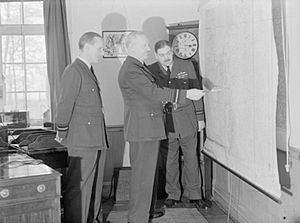Ronald Graham (RAF officer) facts for kids
Quick facts for kids
Ronald Graham
|
|
|---|---|

Graham in 1945, by Thomas Cantrell Dugdale
|
|
| Born | 19 July 1896 Yokohama, Japan |
| Died | 23 June 1967 (aged 70) Sannox, Isle of Arran, Scotland |
| Allegiance | United Kingdom |
| Service/ |
Royal Navy (1915–18) Royal Air Force (1918–48) |
| Years of service | 1915–48 |
| Rank | Air vice-marshal |
| Unit | Seaplane Defence Flight No. 13 Squadron RNAS |
| Commands held | RAF Staff College, Bracknell (1945) RAF Staff College, Bulstrode Park (1944–45) AHQ West Africa (1944) RAF Kenley (1930) No. 233 Squadron (1918–19) No. 213 Squadron (1918) Seaplane Defence Flight (1917–18) |
| Battles/wars | First World War Second World War |
| Awards | Companion of the Order of the Bath Commander of the Order of the British Empire Distinguished Service Order Distinguished Service Cross & Bar Distinguished Flying Cross Mentioned in Despatches Knight of the Legion of Honour (France) Croix de guerre (France) Officer of the Order of the Crown (Belgium) |
| Other work | Commandant of the Scottish Police College |
Ronald Graham was a brave Scottish pilot who became a "flying ace" during the First World War. A flying ace is a military pilot who shoots down five or more enemy aircraft. He was born on July 19, 1896, and passed away on June 23, 1967.
Graham first served in the Royal Naval Air Service, which was the air force branch of the British Navy. After the First World War, he continued his career in the Royal Air Force (RAF). He rose to a very high rank, becoming an Air vice-marshal during the Second World War.
Contents
Ronald Graham's Early Life and War Service
Ronald Graham was studying to become a doctor when the First World War started in 1914. In 1915, he decided to join the military. He first joined the Royal Naval Division. Later that year, he moved to the Royal Naval Air Service (RNAS). This was the part of the navy that used aircraft. He started as a flight sub-lieutenant, which is a junior officer rank for pilots.
Flying in the First World War
In 1916, Graham was stationed at the Dover Seaplane Base in England. He then moved to Dunkirk, a city in France. From there, he flew missions to protect the British Navy's ships in the North Sea. Flying over the sea was risky. On two occasions, his plane was forced to land in the water.
In June 1917, he joined a special group called the Seaplane Defence Flight at Saint Pol. This unit's job was to defend against enemy seaplanes. It was here that Graham achieved his first two victories.
- On June 19, he destroyed a German seaplane while flying a Sopwith Baby aircraft.
- On August 12, 1917, he destroyed another enemy plane. This victory was shared with another pilot, Leonard Slatter. Graham was flying a Sopwith Pup for this mission.
Becoming a Flying Ace
His unit later became known as No. 13 Squadron RNAS. Graham then started flying Sopwith Camel planes, which were famous fighter aircraft. He achieved three more victories with this new plane:
- On September 15, he shared his third victory with Leonard Slatter.
- He destroyed two more enemy planes on his own, one on September 25 and another on October 19, 1917.
These five victories made him a "flying ace." However, on December 29, 1917, he had a serious accident. He crashed his plane and was badly hurt. After he recovered, he returned to his squadron. It had been renamed No. 213 Squadron RAF. He took command of this squadron in May 1918.
In August 1918, he took command of a new unit, No. 233 Squadron RAF. This squadron had different parts, including a fighter group and seaplane group. By March 1919, the squadron's main base moved to RAF Walmer. In total, Ronald Graham was officially credited with five aerial victories during the First World War.
Ronald Graham in the Second World War

When the Second World War began in 1939, Ronald Graham was an air commodore. This is a high rank in the Royal Air Force. He worked at the headquarters of RAF Fighter Command. This command was responsible for defending Britain from enemy air attacks. He played an important role in planning and organizing air operations during the war.
After a long and distinguished career, Ronald Graham retired from the Royal Air Force in 1948. He then took on a new role as the head of the Scottish Police College.

